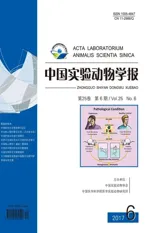新生儿坏死性小肠结肠炎动物模型研究进展
2017-01-17杨凯蒂贺雨曾本华肖洒艾青魏泓余加林
杨凯蒂,贺雨,曾本华,肖洒,艾青,魏泓,余加林
(1.重庆医科大学附属儿童医院新生儿中心,重庆 400014; 2.深圳大学总医院儿科,深圳 518055; 3.儿童发育疾病研究教育部重点实验室,重庆 400014; 4.儿童发育重大疾病国家国际科技合作基地,重庆 400014; 5.儿科学重庆重点实验室,重庆 410014; 6.第三军医大学基础部实验动物学教研室,重庆 400038)
研究进展
新生儿坏死性小肠结肠炎动物模型研究进展
杨凯蒂1,3,4,5,贺雨1,3,4,5,曾本华6,肖洒1,3,4,5,艾青1,3,4,5,魏泓6,余加林1,2,3,4,5*
(1.重庆医科大学附属儿童医院新生儿中心,重庆 400014; 2.深圳大学总医院儿科,深圳 518055; 3.儿童发育疾病研究教育部重点实验室,重庆 400014; 4.儿童发育重大疾病国家国际科技合作基地,重庆 400014; 5.儿科学重庆重点实验室,重庆 410014; 6.第三军医大学基础部实验动物学教研室,重庆 400038)
新生儿坏死性小肠结肠炎(NEC)是新生儿时期严重的胃肠道疾病,病死率高,多见于早产儿,极低出生体重儿,但确切病因及发病机制尚未阐明。积极探寻其发病机制,需建立可靠的动物模型以助于对该病的病因、发病机制及防治等各方面进行深入研究,以改善NEC患儿预后有重要意义。
坏死性小肠结肠炎;动物模型;新生儿
新生儿坏死性小肠结肠炎(necrotizing enterocolitis,NEC)是新生儿重症监护病房常见的胃肠道急症,病死率20%~40%,需手术治疗的NEC患儿病死率高于50%[1,2]。在美国,每年治疗NEC的财政投入达10亿美元。然而目前NEC确切的病因及发病机制尚未阐明,大量研究发现,早产、高渗性的人工喂养、缺氧及肠道菌群紊乱是NEC发病的重要危险因素[3]。因此,建立可靠、高效、高重复性的NEC动物模型对深入研究疾病的发生、发展及早期干预尤为重要。本文就近年来NEC动物模型建立研究进展作一综述。
1 NEC建模常用动物种类
NEC建模的主要动物种类有猪、大鼠和小鼠。猪是较早运用于NEC建模的动物。研究发现,早产猪与早产新生儿在呼吸系统、代谢及心血管疾病方面有很大的相似性,生后及喂养后均易发生NEC[4]。用于NEC建模的小型猪,其体重、内脏器官的形态学及发育过程与人类过程相似且新生猪的体积较大,可操作性强,其建模成功率在55%~65%左右[5]。但由于猪的孕期及生长周期较长,价格也相对昂贵,近年来并不是NEC建模的首选动物[4]。目前更常用于NEC建模的为啮齿类动物大鼠及小鼠。大鼠最早于1974年被运用于NEC疾病模型的建立。建模后病理变化、临床表现及生化反应与人类较为接近,且新生鼠体积较大,操作性较强,目前仍较多用于NEC动物模型的建立[6]。但随着人工喂养技术的改善,免疫学及基因学研究的深入,越来越多的NEC模型建立是基于小鼠进行的。其品系稳定,繁殖迅速。较大鼠而言,小鼠在肠道发育、解剖结构和生理特性方面和人更接近,且遗传背景清晰,其基因与人类有极高的相似度,适合做基因学方面的研究。常用的小鼠种类有KM小鼠、BALB/c以及C57BL小鼠等。一项对KM小鼠及C57BL小鼠人源菌群模型建立的研究表明,在与人的相似性方面,C57BL小鼠显著高于KM小鼠[7]。C57BL小鼠目前多用于肠道菌群与NEC发病机制的研究。
2 NEC建模常用方法进展
因NEC与早产、高渗喂养、缺氧等因素有关,因此早期研究采用了单因素建模法,主要有缺氧-复氧、缺血-再灌注以及单纯注射炎性介质。早期研究发现,肠道的缺血坏死与缺氧时间及复氧浓度呈正相关性。长时间的缺氧及高浓度的复氧更易出现肠壁囊样积气表现,这与高氧产生的氧自由基导致肠道微循环障碍加重有关[8]。目前国内外尚无统一的缺氧窒息时间,多数文献推荐10 min,甚至更长[9]。而缺血时血液首先供应心脑肾等主要器官,由于供血减少,肠道出现不同程度的出血坏死[10]。单纯注射炎性介质(如LPS,PAF,TNF-α)可造成肠道确切损伤,且程度较重,动物多出现腹胀、腹泻及便血的胃肠道表现[11]。但经反复研究证实,上述的三种单因素方法都有缺陷,建模后的症状及病理变化与典型NEC表现不符,且不能重复出临床NEC的复杂病因,故目前已很少使用[12,13]。为了更进一步模拟临床上NEC的多种致病因素,一些新型的多因素建模方法被广泛利用。包括的主要因素有早产、人工喂养、缺氧、冷刺激、生物介质灌胃以及粪菌移植等。这些方法的综合运用,使建模重复性提高,建模后临床表现及病理变化更为典型,更加贴近NEC患儿的自然发病过程。以下就目前NEC多因素建模方法的进展进行阐述。
2.1 基于早产的多因素建模法
流行病学研究表明,早产是NEC发病的危险因素。早产新生儿其胃肠道的许多正常生理屏障发育不良、肠道消化能力受损、血液循环障碍,抗炎及防御能力下降,肠道内保护因子的含量也比足月新生儿低[14]。Jensen等[15]在孕母猪106天建立早产新生猪模型,进行人乳喂养8~9 d,获得NEC早产猪模型。Nguren等[16]在生后4 d对早产新生小鼠腹腔注射109CFU/kg表皮葡萄球菌,建立NEC模型。郑晓辉等[17]将早产的新生大鼠分为三组,分别给予人工喂养+缺氧+冷刺激+LPS灌胃;人工喂养+缺氧+冷刺激及单独缺氧组。建模后发现,人工喂养+缺氧+冷刺激+LPS灌胃组大鼠NEC的发生率更高,其建模后临床表现、肠道病理变化都较其他两组更为典型,更加接近NEC的发病表现。
2.2 基于人工喂养的多因素建模法
由于配方乳中缺少分泌型IgA (SIgA)、乳铁蛋白、溶菌酶、EGF、PAF降解酶、白细胞介素-10 (IL-10)、及益生菌等母乳中所具有的保护因子,高渗性配方乳过快喂养还致使肠腔膨胀、压力增高、肠黏膜缺血而引起肠道损伤。因此高渗性配方乳大量、快速喂养可使肠黏膜渗透性增加,是NEC发病的危险因素之一。母乳喂养新生儿NEC的发病率远低于人工喂养儿[18]。动物实验研究发现,人工喂养组新生猪NEC的发病率是母乳喂养组10倍[10]。目前已成功运用人工喂养+缺氧+冷刺激及人工喂养+缺氧+LPS灌胃的方法成功建立了大鼠NEC模型[19,20]。
Leaphart等[21]在2006年采用人工喂养、缺氧、冷刺激等办法已成功建立了NEC新生小鼠模型。Jung等[19]对人工喂养+缺氧+冷刺激建立的大鼠NEC模型及缺血-再灌注小鼠NEC模型对比发现,两组小鼠回肠均出现不同程度绒毛坏死、肠腺破坏、肠穿孔等,但大鼠组建模后肠壁积气更明显,而小鼠组仅仅是出现腹水,肠道弹性差,肠管扩张及充血,说明大鼠对该种模型更加敏感。Liu等[22]将新生小鼠暴露于缺氧及冷刺激中,用配方奶(4次/日、4天)喂养,并结合缺氧及冷刺激的方法,成功建立NEC疾病模型。
2.3 基于生物介质的多因素建模法
NEC作为新生儿期严重的胃肠道感染性疾病,其动物模型的建立可模拟感染性疾病的发病过程。早期大量研究利用给实验动物注射或喂养LPS的方法来造模。近期对成人炎症性肠病的研究发现右旋糖酐硫酸酯钠 (dextran sodium sulfate,DSS)建模引起肠道上皮血管通透性增强、炎症因子上调及嗜中性粒细胞浸润,其肠道炎性表现具有与人类相似的特征,如腹泻,结直肠出血,体重减轻,短肠综合征等,组织学特征多发糜烂和炎症性黏膜变化及隐窝脓肿[23]。因此DSS可被用于成年小鼠炎症性肠病的建模,其建模成功率高,稳定性佳[24]。近年来,DSS也被用于NEC建模。Ginzel等[25]将3 d的新生小鼠分为LPS+缺氧+冷刺激(2次/日、3 d)及DSS+缺氧+冷刺激(2次/日、8 d)两组,两组建模后对比发现DSS灌胃组相比LPS建模小鼠体重下降更为明显,出现明显的单核巨噬细胞的聚集及NEC样肠道损伤,炎症因子分泌较LPS灌胃组增加,加之DSS对肠上皮细胞无毒性作用,逐渐被用于替代LPS进行NEC建模。
2.4 基于细菌定植的多因素建模法
许多研究发现,肠道菌群的改变是NEC的重要致病因素。NEC患儿较正常组患儿其肠道菌群多样性下降,菌群的构成比也发生了一定的改变[26]。Autrar等[27]运用克雷伯菌定植+人工喂养+缺氧的方法建立了大鼠NEC模型。Tian等[28]运用成人肠道共生菌或粪肠球菌(105CFU)灌胃定植+人工喂养+缺氧+冷刺激成功建立NEC模型。有学者认为,NEC发病过程是多种细菌共同作用所致菌群改变产生,因此,直接运用患儿粪菌移植的建模方法被提出。
2.5 基于基因缺陷动物的多因素建模法
迄今为止,虽然NEC确切的病因及发病机制尚未被完全阐明,但随着基因学及免疫学的发展,为了更好地探讨NEC发病机制,越来越多的研究成功将NEC疾病模型建立于基因缺陷动物,以期阐明靶向基因在NEC中的作用。基因缺陷小鼠较正常小鼠存活率下降,繁殖能力减弱,因此对其进行NEC造模具有一定难度。
2.5.1 ASL缺陷小鼠NEC模型
Premkumar等[29]在2012年利用早产小鼠,采用缺氧、冷刺激,LPS灌胃的方法成功建立了精氨琥珀酸裂解酶(argininosuccinate lyase,ASL)缺陷小鼠NEC模型。新生儿哺乳动物精氨酸的合成取决于ASL,肠细胞是精氨酸合成的主要部位,是人体内转化生产尿素的关键步骤。肠细胞特异性ASL缺乏小鼠其NEC发病率及严重程度都较正常小鼠高,这可能与肠道凋亡增加相关炎症有关。上述研究证明肠细胞衍生的ASL在NEC的发病机制中的保护作用。
2.5.2 SIGIRR缺陷小鼠NEC模型
早期研究发现,Toll样受体4 (Toll-like receptor 4,TLR4)参与了NEC的发生[30],且LPS 信号转导主要通过TLR4进行[31]。Fawley等[32]运用人工喂养+缺氧+LPS灌胃的方法成功在单免疫球蛋白介素-1相关受体(single immunoglobulin interleukin-1 related receptor,SIGIRR)缺陷小鼠上建立NEC模型。上述研究阐述了SIGIRR是肠道发育中TLR4信号传导的负调节因子,其不足可导致肠道对TLR高反应[33,34],引起NEC的发生,进一步证明了TLR4在NEC发病中的重要作用,与Jilling及Leaphart早期研究结果一致[35,36]。
2.5.3 Rag1缺陷小鼠NEC模型
Egan等[37]运用人工喂养+缺氧+粪便菌群移植成功在重组激活基因1(recombination activating gene 1-deficient,Rag1-/-)缺陷小鼠上诱导出NEC模型。由于Rag1-/-小鼠体内发挥免疫效应的功能性T、B淋巴细胞的不足,建模后其肠道损害程度及促炎因子白细胞介素1β(IL-1β)低于野生型小鼠(Wild Type,WT)。转入CD4+的天然样淋巴细胞(Naive T)于Rag1-/-小鼠体内,这些小鼠便恢复了NEC敏感性,肠道损害程度加重,IL-1β分泌增加。证实NEC发病机制中T细胞发挥主要作用。
综上所述,理想的NEC动物模型应具有与临床NEC发病近似匹配的在病因、病理、生化及临床表现,较强的可重复性及良好的操作性与简便易行的方法是建模成功的关键。仍需大量的动物实验和临床研究来完善建模方法,并利用好基因工程小鼠及人源化小鼠等工具,最终建立较为理想的NEC动物模型,以更好的了解NEC的病因及发病机制,达到疾病早期预防及改善NEC患儿的预后。
[1] Neu J.Necrotizing enterocolitis: the mystery goes on [J].Neonatology,2014,106(4): 289-295.
[2] Miner CA,Fullmer S,Eggett DL,et al.Factors affecting the severity of necrotizing enterocolitis [J].J Matern Fetal Neonatal Med,2013,26(17): 1715-1719.
[3] Neu J,Walker WA.Necrotizing enterocolitis [J].New Engl J Med,2011,364(3): 255-263.
[4] Sangild PT,Thymann T,Schmidt M,et al.Invited review: the preterm pig as a model in pediatric gastroenterology [J].J Anim Sci,2013,91(10): 4713-4729.
[5] Ewer AK,A1-Salti W,Coney AM,et al.The role of platelet activating factor in a neonatal piglet model of necrotising enteroeolitis [J].Gut,2004,53(2): 207-213.
[6] Sangild PT.Gut responses to enteral nutrition in preterm infants and animals [J].Exp Biol Med (Maywood),2006,231(11): 1695-1711.
[7] 张晓婧,曾本华,刘智伟,等.两种不同品系小鼠的人源菌群模型的建立与肠道菌群的比较[J].中国微生态学杂志,2013,25(4): 376-780.
[8] Haase E,Bigam DL,Nakonechny QB,et al.Resuscitation with 100% oxygen causes intestinal glutathione oxidation and reoxygenation injury in asphyxiated newborn piglets [J].Ann Surg,2004, 240(5): 364-373.
[9] 李金纯,韦红,贾盛华,等.新生儿坏死性小肠结肠炎动物模型建立方法改进与比较 [J].重庆医科大学学报,2009,34(3): 313-317.
[10] Nowickj PT,Dunaway DJ,Nankervis CA,el al.Endothelin-1 in human intestine resected for necrotizing enteroeolitis [J].J Pediatr,2005,146(6): 805-8l0.
[11] Gellrn B,Kovdcs J,Nrmeth L,et al.Vascular changes play a role in the pathogenesis of necrotizing entemcolitis in asphyxiated newhom pigs [J].Pediatr Surg Int,2003,19(5): 380-384.
[12] Sangild PT,Siggers RH,Schmidt M,et al.Diet- and colonization-dependent intestinal dysfunction predisposes to necrotizing enterocolitis in preterm pigs [J].Gastroenterology,2006,130(6): 1776-1792.
[13] Chan KL,Hui CW,Chan KW,et al.Revisiting ischemia and reperfusion injury as a possible cause of necrotizing entemcolitis: role of nitric oxide and superoxide dismutase [J].J Pediatr Surg,2002,37(6): 828-834.
[14] Anand RJ,Leaphart CL,Mollen K,et al.The role of the intestinal barrier in the pathogenesis of necrotizing enterocolitis [J].Shock,2007,27(2): 124-133.
[15] Jensen ML,Thymann T,Cilieborg MS,et al.Antibiotics modulate intestinal immunity and prevent necrotizing enterocolitis inpreterm neonatal piglets [J].Am J Physiol Gastrointest Liver Physiol,2014,306(1): 59-71.
[16] Nguyen DN,Stensballe A,Lai JC,et al.Elevated levels of circulating cell-free DNA and neutrophil proteins are associated with neonatal sepsis and necrotizing enterocolitis in immature mice,pigs and infants [J].Innate Immun,2017,23(6): 524-536.
[17] 郑晓辉,周伟,荣箫,等.早产大鼠坏死性小肠结肠炎三种常用模型的建立及评价 [J].中华围产医学杂志.2010,13(2): 408-412.
[18] Brown JV,Embleton ND,Harding JE,et al.Multi-nutrient fortification of human milk for preterm infants [J].Cochrane Database Syst Rev,2016(5): CD000343.
[19] Jung K,Kim JH,Cheong HS,et al.Gene expression profile of necrotizing enterocolitis model in neonatal mice [J].Int J Surg,2015,23(Pta): 28-34.
[20] Cekmez F,Purtuloglu T,Aydemir G,et al.Comparing beneficial effects of inhaled nitric oxide to L-arginine in necrotizing enterocolitis model in neonatal rats [J].Pediatr Surg Int,2012,28(12): 1219-1224.
[21] Leaphart CL,Qureshi F,Cetin S,et al.Interferon-gamma inhibits intestinal restitution by preventing gap junction communication between enterocytes [J].Gastroenterology,2007,133(5): 2395-2411.
[22] Liu Y,Tran DQ,Fatheree NY,et al.Lactobacillus reuteri DSM 17938 differentially modulates effector memory T cells and Foxp3+regulatory T cells in a mouse model of necrotizing enterocolitis [J].A J Physiol Gastrointest Liver Physiol,2014,307(2): G177.
[23] Okayasu I.Development of ulcerative colitis and its associated colorectal neoplasia as a model of the organ-specific chronic inflammation-carcinoma sequence [J].Pathol Int.2012,62(6): 368-380.
[24] Eggre B,Bajaj-Elliottb M,Macdonaldm T,et al.Characterisation of acute murine dextran sodium sulphate colitis: cytokine profile and dose dependency [J].Digestion,2000,62(4): 240-248.
[25] Ginzel M,Feng X,Kuebler JF,et al.Dextran sodium sulfate (DSS) induces necrotizing enterocolitis-like lesions in neonatal mice [J].Plos One,2017,12(8): e0182732.
[26] Lin PW,Stoll BJ.Necrotising enterocolitis [J].Lancet,2006,368(9543): 1271-1283.
[27] Autran CA,Kellman BP,Kim JH,et al.Human milk oligosaccharide composition predicts risk of necrotising enterocolitis in preterm infants [J].Gut,Published Online First: 05 April 2017,doi: 10.1136/gutjnl-2016-312819
[28] Tian R,Liu SX,Williams C,et al.Characterization of a necrotizing enterocolitis model in newborn mice [J].Int J Clin Exp Med,2010,3(4): 293-302.
[29] Premkumar MH,Sule G,Nagamani SC,et al.Argininosuccinate lyase in enterocytes protects from development of necrotizing enterocolitis [J].Am J Physiol Gastrointest Liver Physiol,2014,307(3): G347-354.
[30] Gribar SC,Sodhi CP,Richardson WM,et al.Reciprocal expression and signaling of TLR4 and TLR9 in the pathogenesis and treatment of necrotizing enterocolitis [J].J Immunol,2009,182(1): 636-646.
[31] Beutler BA.TLRs and innate immunity [J].Blood,2009,113 (7): 1399-1407.
[32] Fawley J,Cuna A,Menden HL,et al.Single immunoglobulin interleukin-1 related receptor (SIGIRR) regulates vulnerability to TLR4 mediated necrotizing enterocolitis in a mouse model [J].Pediatr Res,2017 Oct 4,doi:10.1038/pr.2017.211.
[33] Riva F,Bonavita E,Barbati E,et al.TIR8/SIGIRR is an interleukin-1 receptor/Toll like receptor family member with regulatory functions in inflammation and immunity [J].Front Immunol,2012,322(3): 1-13.
[34] Garlanda C,Anders HJ,Mantovani A,et al.TIR8/SIGIRR: an IL-1R/TLR family member with regulatory functions in inflammation and T cell polarization [J].Trends Immunol,2009,30(9): 439-446
[35] Jilling T,Simon D,Lu J,et al.The roles of bacteria and TLR4 in rat and murine models of necrotizing enterocolitis [J].J Immunol,2006,177(5): 3273-3282.
[36] Leaphart CL,Cavallo J,Gribar SC,et al.A critical role for TLR4 in the pathogenesis of necrotizing enterocolitis by modulating intestinal injury and repair [J].J Immunol,2007,179(7): 4808-4820.
[37] Egan CE,Sodhis CP,Good M,et al.Toll-like receptor 4-mediated lymphocyte influx induces neonatal necrotizing enterocolitis [J].J Clin Invest,2016,126(2): 495-508.
Progressinresearchonanimalmodelsofneonatalnecrotizingenterocolitis
YANG Kai-di1,3,4,5,HE Yu1,3,4,5,ZENG Ben-hua6,XIAO Sa1,3,4,5, AI Qing1,3,4,5,WEI Hong6,YU Jia-lin1,2,3,4,5*
(1.Department of Neonatology,Children’s Hospital of Chongqing Medical University,Chongqing 400014,China; 2.Shenzhen University General Hospital,Shenzhen 518055; 3.Ministry of Education Key Laboratory of Child Development and Disorders,Chongqing 400014; 4.China International Science and Technology Cooperation Base of Child Development and Critical Disorders,Chongqing 400014; 5.Chongqing Key Laboratory of Child Infection and Immunity,Chongqing 400014; 6.Department of Laboratory Animal Science,College of Basic Medicine,Third Military Medical University,Chongqing 400038)
Neonatal necrotizing enterocolitis (NEC) is a severe gastrointestinal disease with high mortality.Studies have suggested that NEC are associated with prematurity and very-low birth weight,but the exact etiology and pathogenesis has not been elucidated.Therefore,it is important to build an ideal NEC model to explore the pathogenesis and prevention measures of NEC to reduce the incidence and severity of NEC.
Neonatal necrotizing enterocolitis; Animal model
Yu Jia-lin.E-mail: yujialin486@126.com
杨凯蒂(1992-),女,博士,主要从事新生儿感染性疾病研究。Email:chinaykd@sina.com
余加林(1961-),男,博士,教授,博士生导师,主要从事新生儿疾病研究。Email:yujialin486@126.com
Q95-33
A
1005-4847(2017) 06-0689-04
10.3969/j.issn.1005-4847.2017.06.019
2017-10-13
